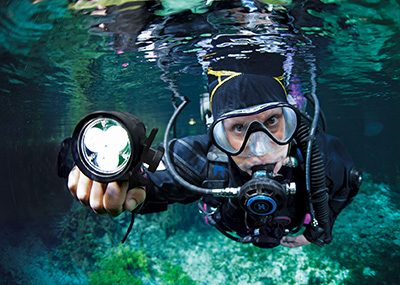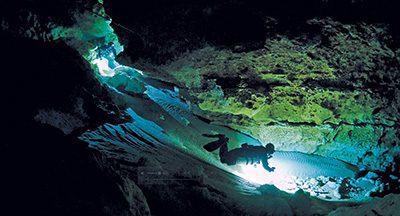MY DIVE BUDDY AND I planned to do a longer than usual dive one Saturday morning at Madison Blue Spring State Park in Lee, Florida. For several years and more than 100 cave dives together, we had built up our experience as a team and our time spent in this specific underwater cave system in northern Florida. We had slowly extended the duration and distance of our dives in this labyrinth of underwater tunnels that weaved throughout the karst limestone of the park, increasing our familiarity with the system while also practicing the skills that we had learned and continued to build on to be safe cave divers.
The dive plan was to swim approximately 3,500 feet (1.067 meters) into the system or return when one of us had breathed one-third of our gas supply. We geared up and walked down to the spring, observing that the water was air-clear, like many of the Florida’s freshwater springs.
After completing our predive equipment checks and reviewing our dive plan, we submerged and made our way into the cave system. Our lights bounced off of the glistening white limestone walls as we swam through the tunnels. Despite being familiar with the cave from dozens of previous dives, we took our time and paid attention to its details to remain aware of our surroundings.
As cave divers we learn a variety of skills for emergency situations, including how to manage loss of our primary light. We each carry two backup lights, smaller with a narrower field of view. Approximately 2,000 feet (610 meters) into our dive my primary light went out, so I instantly reached over for my first backup light. Although it was working when I tested it as part of our predive check, my backup light now would not turn on.
My dive partner noticed that my light beam was gone, and he stayed next to me as I worked through the situation. My second backup light turned on, but I was now down to one light while over a third of a mile back in an underwater cave.
My dive buddy gave me one of his backup lights so that I had two working lights. We also used a traveling configuration where we were in physical contact with each other as we turned to swim out of the cave. By doing this we would be able to use touch communication if necessary and could rely on his working lights, and we wouldn’t have to look for each other in case my last light failed.
We slowly made our way back toward the entrance, being careful when making turns to not lose contact with each other. About 1,000 feet (305 meters) from the entrance my dive buddy’s primary light failed, and the cave went pitch black. He tried to turn on his backup light, but it didn’t work. Now we were down to only two working lights between the two of us.
I gave him his original backup light, and we continued to make our way toward the cave’s entrance. We maintained contact with each other while also following the line by touch in the event we lost visibility due to a silt-out or more light failures.
Even though every light was working at the surface during our predive checks, today’s dive would seriously test our light management skills. About 500 feet (152 meters) from the cave entrance my remaining light went dark. I tucked away the dead light and looked to my dive partner, who had the only remaining light, but it was visibly going dim. The last of our six lights died approximately 300 feet (91 meters) from the entrance, and we were in a total lights-out situation.


My buddy nudged me to keep swimming forward in the dark. We were careful to not lose contact with each other or the line — breathing calmly, staying as relaxed as possible, and moving slowly to make our way out safely. We finally saw a glimmer of light from the cave entrance shining like a beacon.
We made our way back into the cavern to decompress, thankful for the natural light that illuminated our surroundings. After fulfilling our decompression obligation, we slowly made our way out of the cavern and to the surface.
Proper line management is a key component of cave diving. A cave diver always has a continuous line back to open water and must be aware of it at all times. Maintaining team awareness is also vital. When my first light went out, my buddy was able to find me immediately because he knew where I was. If he had been unaware of my location, it would have taken longer to assess and manage the situation.
Always pay attention to where your dive buddies are, how much breathing gas they have, and if they are having any issues. Be familiar with how their gear is set up so you can ensure a smooth and efficient response to any problems that arise.
Cave divers have a system of redundancy for every piece of critical equipment, including regulators, tanks, and lights. Planning for emergencies is important, but proper skills training and practicing those skills are essential to survival. Switching to our backup lights and using the skills we were taught for handling a lights-out situation was muscle memory to us, which minimized our stress.
Every diver must learn to keep calm during every dive. “Slow and relaxed with good technique” is a mantra that dive instructor Larry Brown taught us and is a critical mindset to have for every dive.
When things are going as planned, decreased gas consumption and better buoyancy control benefit from the slow and relaxed breathing that comes with maintaining a calm mindset during a dive. Similarly, staying calm and engaging in the skills you have learned and practiced will improve how efficiently you respond to emergencies when the dive plan shifts. AD
© Alert Diver - Q4 2023